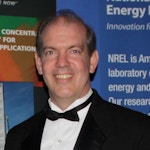Separating Direct From Diffuse
Observations of Visible Transmittance Through a Tracking Photovoltaic Envelope
Sign in and Register
Create an Account
Overview
Abstract
An Enclosure-Integrated, Daylighting, Tracking Solar Collector (EIDTSC) has been developed for market which integrates into a building’s fenestration (windows, curtain walls, skylights, canopies) and contributes daylighting, solar gain control, and power. The fundamental means of this active system is optical concentration, by which direct beam irradiance is blocked (and focused into photovoltaic generation). Off-axis irradiance is not focused, and is transmitted. Because transparent optics are a major fraction (by area) of the system’s components, diffuse light passes through, while beam luminance is either blocked or diffused, depending on the chosen tracking mode. The enclosure’s glazing lites can be specified highly transparent and neutrally-colored. The EIDTSC therefore performs daylighting with good color rendering, while reducing contrast-triggered glare and solar heat gain to indoor spaces.
A pre-production EIDTSC assembly has been evaluated for visible light and solar energy transmittance, as installed in a horizontal glazing cassette (skylight configuration). Tests were conducted over intervals of 2.5 to 5 hours, under variable-sky and clear-sky conditions, and operating for either maximum power generation (tracking) or enhanced diffuse daylighting (off-tracking). While tracking, the daily average transmittance ranged from 0.11 (during clear-sky tests) to 0.15 (during variable-sky tests). Steady-state transmittance peaked during cloudy conditions (up to 0.25), indicating beam luminance was preferentially blocked. The average illuminance on a work plane under the cassette was stable, shifting from 10,700lx during variable-sky tests, to 11,100lx under clear skies (a 4% change), indicating the EIDTSC moderated shifts in the sunlight resource. With off-tracking control, mean hemispherical transmittance rose to 0.25, a 108% increase. These results suggest new affordances from dynamic fenestration, such as improved light-to-solar gain (LSG) ratios, greater glazing ratios, and dynamic daylighting control in side-lit spaces. These opportunities could grant more freedom for architectural design, while improving building energy performance and occupant comfort relative to other fenestration strategies.
Authors

Nick Novelli, PhD
Helioptix
nen@helioptix.com

Robert Gordon
Arzon Solar
rgordon@arzonsolar.com
Igor Varfolomeev
Arzon Solar
ivarfolomeev@arzonsolar.com
Keywords
Abbreviations
Access Restricted
Introduction
Discussions of measurable performance continue to permeate the practice of architecture—performance according to environmental, health, comfort, and economic metrics. Active envelope elements—though their application has long been restricted by questions
Access Restricted
Background
Active envelopes can improve the energy use of commercial building stock (Heiselberg 2012), and innumerable concepts and approaches have been investigated and developed. Objectives for adding dynamic (or otherwise active)
Access Restricted
Method
A pre-production assembly of the EIDTSC was installed in a glazed cassette, outfitted with light sensors and solar sensors, and observed in different modes of operation, in different weather conditions
Access Restricted
Results and Discussion
The visible and solar transmittances through the EIDTC are characterized as averages of the ratio between simultaneous measurements at sensors underneath the array (to the interior) and the sensor suite
Access Restricted
Conclusion and Future Work
A pre-production EIDTSC device was tested for visible and solar transmittance. It was observed that average visible transmittance was 0.12 or 0.25, depending on the chosen mode of operation, and
Access Restricted
Acknowledgements
The contributing research and support from the Rensselaer Center for Architecture, Science and Ecology, the Yale Center for Ecology and Architecture, and SHoP Architects are gratefully acknowledged.
Funding was provided internally.
Rights and Permissions
Aschehoug, Øyvind, Jens Christoffersen, Roman Jakobiak, Kjeld Johnsen, Eleanor Lee, Nancy Ruck, and Stephen Selkowitz. 2000. Daylight in Buildings: A Source Book on Daylighting Systems and Components. A Report of IEA SHC Task 21, ECBCS Annex 29. International Energy Agency, IEA, Solar Heating and Cooling Programme, SHC, Energy Conservation in buildings and Community Systems Programme, ECBCS.
Alghamedi, Ramzy, Mikhail Vasiliev, Mohammad Nur-E-Alam, and Kamal Alameh. 2015. “Spectrally-Selective All-Inorganic Scattering Luminophores for Solar Energy-Harvesting Clear Glass Windows.” Scientific Reports 4 (1). doi:10.1038/srep06632.
Aly, Mohamed, Nicholas Evan Novelli, Justin Shultz, Kenton Phillips, Brandon Andow, and Anna Dyson. 2015. “Daylighting Effect of Separating Direct and Diffuse Insolation with Facade-Integrated, Transparent Solar Collector.” In Proceedings of the PLEA Conference. Bologna.
Baig, Hasan, Nazmi Sellami, and Tapas K. Mallick. 2015. “Performance Modeling and Testing of a Building Integrated Concentrating Photovoltaic (BICPV) System.” Solar Energy Materials and Solar Cells 134 (March): 29–44. doi:10.1016/j.solmat.2014.11.019.
Chemisana, Daniel, J. I. Rosell, Alberto Riverola, and Chr Lamnatou. 2016. “Experimental Performance of a Fresnel-Transmission PVT Concentrator for Building-Facade Integration.” Renewable Energy 85: 564–572.
Dyson, Anna. 2003. “Interdisciplinary Co-Development of Intelligent Building Envelopes with On-Site Power Generation.” In 91st ACSA International Conference Proceedings. Helsinki.
Dyson, Anna H., Michael K. Jensen, and David N. Borton. 2007. United States Patent: 7190531 - Concentrating type solar collection and daylighting system within glazed building envelopes. 7190531, issued March 13, 2007.
Dyson, Anna, Ted Ngai, and Jason Vollen. 2011. “Characterizing the Problem: Bioenergetic Information Modeling.” In BIM in Academia. New Haven, CT: Yale School of Architecture.
Dyson, Anna H. 2017. “Intelligent Facades for High Performance Green Buildings. Final Technical Report.” DE--EE0002285(J12155). Rensselaer Polytechnic Inst., Troy, NY (United States). https://www.osti.gov/scitech/biblio/1351620-intelligent-facades-high-performance-green-buildings-final-technical-report.
Heiselberg, Per. “Integrating Environmentally Responsive Elements in Buildings.” 2012. Annex 44. IEA/ECBCS. http://www.ecbcs.org/docs/ECBCS_Annex_44_PSR.pdf.
Konis, Kyle. 2012. “Evaluating Daylighting Effectiveness and Occupant Visual Comfort in a Side-Lit Open-Plan Office Building in San Francisco, California.” Building and Environment. doi:10.1016/j.buildenv.2012.09.017.
Leslie, R.P. 2003. “Capturing the Daylight Dividend in Buildings: Why and How?” Building and Environment 38 (2): 381–85. doi:10.1016/S0360-1323(02)00118-X.
Loonen, R. C. G. M., J. L. M. Hensen, and Xianmei Zhang. 2014. “SolarSwing Energy : An Innovative Building-Integrated Concentrating Photovoltaic Shading Solution.” Built Environment.
National Fenestration Rating Council. 2013. “200A-2014 Procedure for Determining Fenestration Attachment Product Solar Heat Gain Coefficient and Visible Transmittance at Normal Incidence.”
Novelli, Nicholas Evan, Justin Shultz, and Anna Dyson. 2015. “Development of a Modeling Strategy for Adaptive Multifunctional Solar Energy Building Envelope Systems.” In SimAUD. Washington, DC.